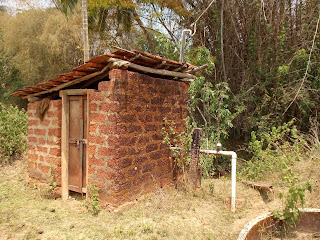Long term goal of
our farm is to build a self sustaining food forest. We planted few hundred saplings in our farm as a step towards that. Though the plants become self sustaining after few years, they need watering in the initial few years until their roots go deep and wide enough to provide them moisture during dry summer months (Feb/Mar - Jun).
We decided to install
drip irrigation to conserve water. We placed 1000 liter water tank at the highest point in the farm and ran drip irrigation lines to the plants from the tank. Now comes the challenge of pumping water into the tank from the well.
 |
| Pond? Nope, it is a well! |
Luckily previous owner of our farm had installed a 5 HP irrigation pump connected to a 30+ year old irrigation well. Well .. well, it does not look like a well any more because the soil from the sides has collapsed into the well in so many years and created a pond. Very soon we will convert it to a proper well - stay tuned for that. We had electricity connection too for the irrigation pump. By the way electricity is free for agriculture purpose in this state. This pump previous owner had installed was a low head (meaning cannot generate lot of pressure to pump water to higher altitudes) pump. That pump could not deliver water to the tank which was easily 50-60 ft above the water level in the well. We told RIP to the old pump, disconnected it and left it in its place. We bought a 1 HP V-Guard pump capable of throwing water to a height of 100 ft. It sucks water through a 32 mm diameter pipe and pushes it out through a 32 mm pipe. We buried approximately 500 ft long PVC pipe from the pump to the tank. From there we laid one main line through one section of the farm to water the plants.
 |
| Old pump house |
Then I connected 16 mm HDPE drip line to take water to the plants from the main line. this 16 mm line runs to almost all the plants. You may say I could have run 12 mm pipes to the plants for cost cutting (obviously 12 mm pipe costs less than 16 mm pipe for the same length). There are less chances of the pipe clogging with debris in water if the pipe is wider - therefore 16 mm is less hassle compared to 12 mm. I decided to go with 16 mm all over because there is no considerable cost difference for the length of pipe we need.
Next important thing in drip irrigation is - emitter. Emitter is the thing which emits water from the drip line to the plants. Emitters are important because they should provide reliable delivery of water to the plants. You know what happens if water is not delivered to the plants properly - yes, they wilt and die. Many shops in my town sell only cheapo unreliable emitters. After quite a bit of search I found Jain 4.2 lph (liters per hour) turbo key pressure compensated emitters. That is the right stuff for our farm because:
- Jain is a known name in irrigation - we are less likely to go wrong with Jain equipment.
- 4.2 liters per hour is right kind of discharge for orchard crops - that is what we have in our farm.
- Turbo key emitter has arrangement to open and clean it when it is clogged with debris from water. Jain sells a key to open it. I open it with God gifted equipment - my hands!
- Pressure compensation is important for our farm because our farm is not flat terrain. From top to bottom of planted area there is at least 10-15 ft. elevation difference. Without pressure compensation plants lower below get more water and the ones at higher elevation get less water because of pressure difference. With pressure compensation we get uniform water delivery (within specified pressure range and manufacturing error in the pressure compensation mechanism within emitters).
 |
| Close-up of the emitter on the drip line |
Total cost of this project came to approximately 30,000 Rs. Mostly one time cost like pump, pipe line etc. With this setup plants are happy and we are happy too because plants are happy :-D. You may be thinking that is a recursive statement!



No comments:
Post a Comment